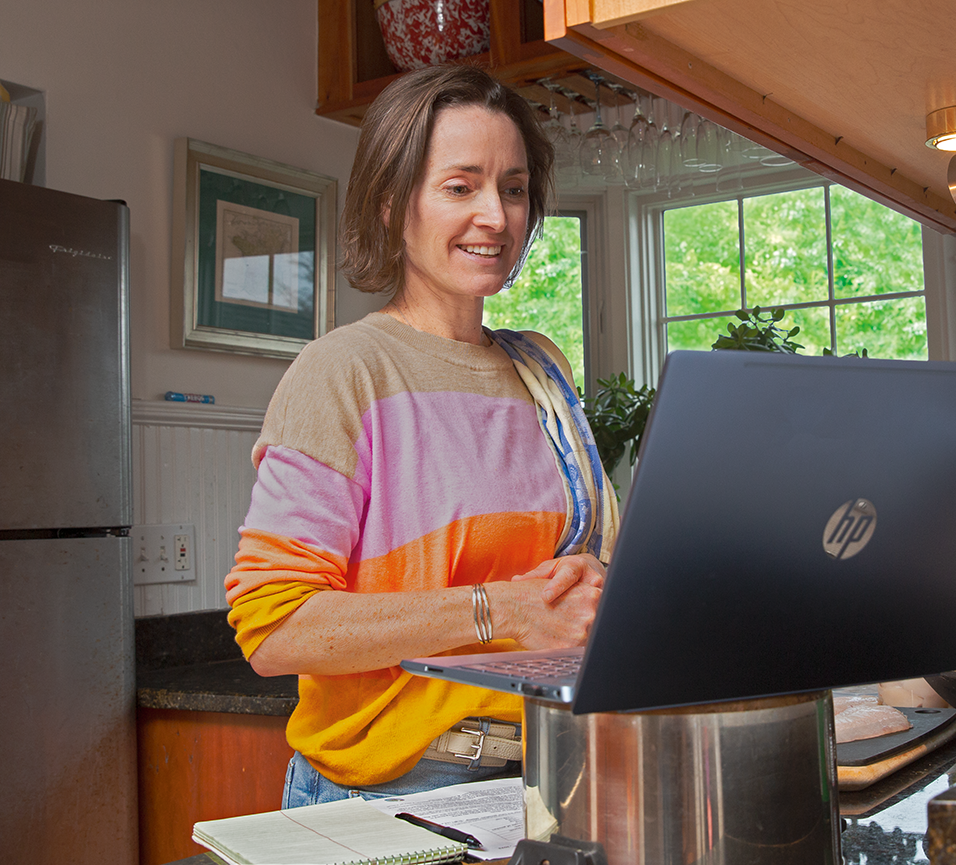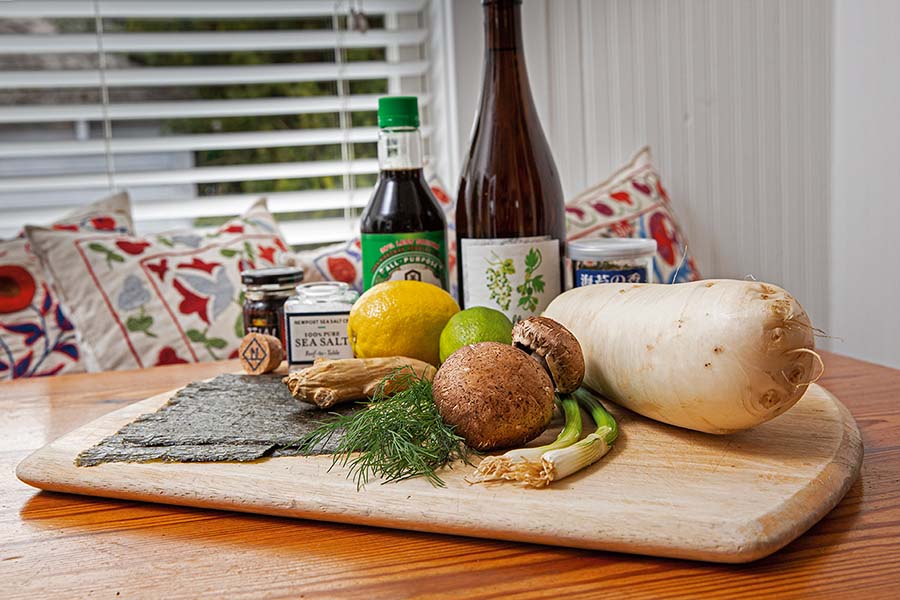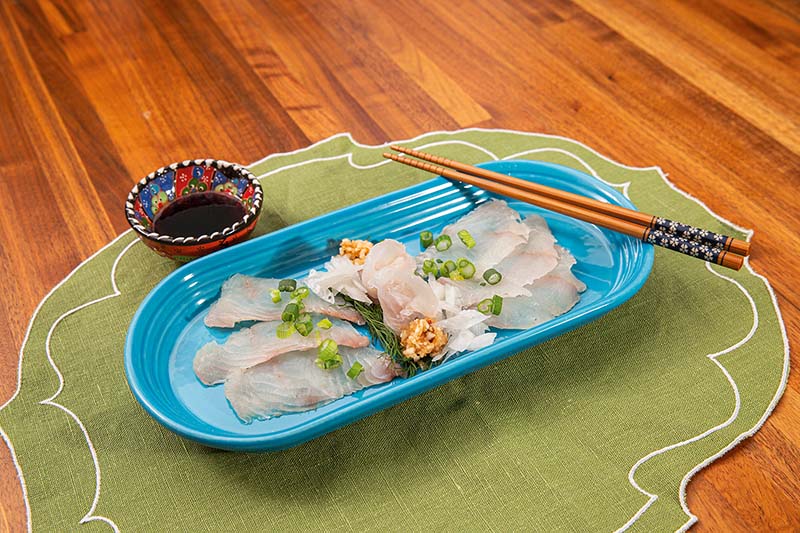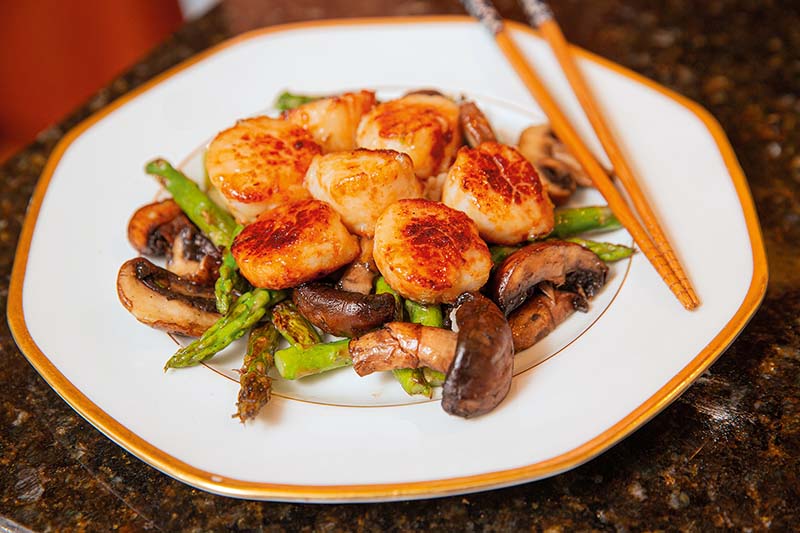Cooking with Confidence
Preparing Rhode Island Seafood at Home
By Annie ShermanChef Youji Iwakura of Washoku Renaissance in Boston teaches how to prepare local seafood. Portrait by Dana Smith.
Have you ever prepared locally sourced sushi? Me either.
I certainly indulge in the fresh raw fish at restaurants, but I had always subliminally treated it like a delicacy for a special occasion, rather than a meal I could serve in my own kitchen on a random Tuesday night. I questioned my abilities, too. What if I used the wrong fish or sliced it incorrectly? Would I get sick if I did it myself?
Turns out, I had it all wrong. Sushi and local Rhode Island seafood are not mutually exclusive, and sushi is not hard to make. I absolved myself of my error during a Japanese cooking class with Eating with the Ecosystem (EWTE), a Rhode Island-based organization that educates consumers about the sustainability and accessibility of New England’s wild seafood.
Chefs teach these classes to help people like me gain comfort with seafood that is caught nearby so we can incorporate it into our routine, rather than relegating it to special occasions or not cooking it at all. That goes for sushi too.
EWTE director Kate Masury says my misconceptions around local seafood are common—many consumers either don’t know what seafood or shellfish is local to their region, or they think it’s difficult to cook. She aims to shatter these myths, and others, with classes and demonstrations that show students that native seafood is attainable, sustainable, easy to prepare, and delicious.
“You may go to a cooking class in the chef’s kitchen, and you think that was fun, but you couldn’t do that at home. But through our classes, you’re doing it yourself at home, which gives you a bigger sense of confidence and a chance to replicate the recipe on your own,” Masury explains. “We want people to help create demand for these local species that are abundant and we should be eating more of.”
Which is exactly what I did.

Annie Sherman follows Chef Iwakura as he demonstrates filleting fluke for sashimi. Photograph by Marianne Lee
PREPARATION
I registered for the “Cook a Fish, Give a Fish” class, during which Chef Youji Iwakura of Washoku Renaissance in Boston would prepare two dishes in a two-hour timeframe, while eager students watched on Zoom and tried to craft our own version. On the menu: usuzukuri sashimi crudo (thin-sliced raw fish) and pan seared soy butter scallops. I am usually an adventurous eater but can be wary of dishes I can’t pronounce, so usuzukuri gave me a momentary pause. I love sashimi and scallops, however, so I was committed to trying something new and not being intimidated by a foreign word.
Armed with a shopping list that included fish, vegetables, spices, and accoutrements, I set out to build my meal. Chef Iwakura had provided ample guidance and specific items to purchase in advance and even offered a discount at a Massachusetts-based fish retailer. But being a Rhode Island gal, I called a few nearby fish markets to see if they had local fluke or black sea bass. Andrade’s Catch in Bristol ordered fluke fillets for me and had delicious local bay scallops readily available.
I easily found many other ingredients at a nearby market, including items I previously thought were specialty, like kanzuri or red yuzu kosho, which I learned is chili paste.
I happened to be near Asiana Market in East Providence, so I stopped in to pick up sheets of nori seaweed, furikake rice seasoning, and good chopsticks. As I searched for daikon radish, which I had never seen before, I walked right past the traditionally gigantic Japanese veggie—at which point staff politely turned me around. Aquidneck Meat Market had Newport Sea Salt for a dash of seaside flavor, and while there, I spotted RI Mushroom Co. shiitake mushrooms, asparagus, and good olive oil for the scallop dish too. I was pleased to keep my dollars within the state all around.
On the night of the class, I set up my laptop on my kitchen counter, gathered utensils and pans, sharpened knives, and prepped ingredients. After a quick roundtable introduction, Chef Iwakura showed us exactly how to fillet the whole fluke or sea bass.
I just watched this part—I already had a fillet from Andrade’s Catch, I was not keen on manhandling a whole fish, and it’s unlikely that I will serve a school-night meal that involves a whole fish versus a fillet. But it was interesting to see his knife techniques at large, and when instructing us on delicately slicing the fillet, we pivoted our grip toward the fish, just like a tennis racquet, laying the knife almost flat against the fillet. This made my usuzukuri sashimi crudo turn out flawlessly after a few incisions.
At first glance, this appeared to be a pretty simple process, and it turned out to be that way too.
All it took was a little practice, proper knife skills, and patience, and within 30 minutes I was relishing locally sourced sashimi that I had sliced myself. It was a deliciously proud moment.
Meanwhile, we worked on the scallops. Scallops are one of my favorite seafoods, so I cook them regularly, yet I struggle with excess liquid in the pan when sautéing, which prevents a good char. But Chef Iwakura’s method converted me, and I will prepare them like this forever after.
Per his instruction, after drying the fleshy bivalve and sprinkling with salt and pepper,
I coated them lightly in flour, then popped them in a warm pan with oil. “When you hear the searing sound, check the color changes on the bottom and side,” he directed. “When about 70 percent of the side becomes white and the bottom becomes golden brown, turn the scallops upside down just to kiss the pan (10 to 15 seconds) and set them aside.”
It doesn’t matter if you have the exact amount or type of ingredients listed.

Photograph by Marianne Lee
He made it sound so easy. And of course, it was, in hindsight. But then he started moving fast because we were running out of time, and I just had to make my meal, try to listen to his instructions subconsciously, and hope I didn’t go astray. I blanched the asparagus quickly to speed up cooking time, sliced the mushrooms, and popped it all into another warm saucepan with oil for a rapid sauté. Then using the scallop pan with all the yummy crispy bits, I added soy sauce, butter, and lemon, which warmed into a satisfying gel reminiscent of poached egg yolk.
“Add the scallops back to the pan,” Chef Iwakura instructed, “and turn off the heat when the texture is still bouncy.”
And itadakimasu! (“I humbly receive” in Japanese, which is like “Bon Appetit” in French). A delicious and healthy home-cooked meal using fresh ingredients caught just offshore, plus recipes I can return to again and again.
Though it was difficult to simultaneously watch the chef and cook, that was more an issue with my kitchen layout than the instruction. The actual “cheffing” was relatively seamless, and I enjoyed it so much that a few weeks later, I attended another cooking class with a different chef to complement my repertoire.
BENEFITS
It’s well known that supporting local business is a boon for any economy, and that applies to the fishing industry too. Purchasing local seafood reduces fossil fuel emissions in shipping, among other environmental benefits, Masury says.
And underutilized fish are plentiful since they’re not typically overfished. They’re also less expensive, explains Kristin Gerbino, a fisheries specialist with Cornell Cooperative Extension in New York, which partners with Masury on the classes.
“What we realized is that there was really a need for more consumer awareness around what fisheries are local to the region, what fish are available, where people can buy them, why it’s important to choose local fish, and just the fact that there’s plentiful fish species and a vibrant commercial fishing industry around us, yet what consumers are choosing and what the restaurants are serving typically is not what’s [locally] available,” Gerbino says.
LESSONS
This opportunity rid my mind of fears and stereotypes around native seafood and foreign cooking. Unfortunately, it’s easy to fall into a rut, in terms of cooking and approaches to meals and ingredients. But the benefits of trying new seafood and cooking techniques are also easy to attain with a little forethought. So I embraced the experience wholeheartedly and really had fun learning what I hope will become new routine recipes for my family.
Though it worked out well, there were some challenges.
Availability can be limited depending on your location. I cannot typically find native seafood at a traditional retail grocer, so I didn’t expect to now. Plus, I anticipated fluke might be a little more difficult to source overall, so I called Andrade’s a week in advance of the class. I’m glad I did because they didn’t have any in stock, so I placed a special order. That was common for them, but added a layer of complexity for me in that it was less convenient. Of course, they had plenty of other native fish and shellfish species, just not he kind I needed for class.
“Frequently, markets don’t carry some of these (local) species because they don’t think customers will buy them,” Masury says, “but by creating that demand and having customers ask for those fish, that helps the markets actually want to carry those fish because they see demand for it.”
Be flexible.
- I learned later that it doesn’t matter if you have the exact amount or type of ingredients listed on the recipe—as long as it’s similar, it will suffice for the class and other dishes too. So if you want something specific, don’t be afraid to ask the fish market for it. But also, it’s ok to be flexible, so next time, if fluke or sea bass are not available, I can use sea robin or haddock, which are two other readily available native whitefish.
It was expensive.
- I paid $70 just for the seafood for this dish, plus $40 in other ingredients I didn’t have in my pantry or fridge. For another cooking class, I spent nearly $100 on the seafood. So it can be tough to eat seafood if you’re on a budget.
“When you see $25 or $30 a pound for something like scallops, that’s definitely a deterrent,” Gerbino says. “And that’s one reason why we are trying to get people to think outside the box and think about skate wings, which are very inexpensive compared to a lot of other fish.”
I hustled and researched to find these ingredients. From ordering the seafood, to finding the stores that sold unique Japanese items I didn’t recognize, I ultimately went to four different shops. The benefits of spreading dollars around the community and supporting my neighbors far outweigh any perceived hassle, and it will likely be quicker now that I have the staple ingredients.
In hindsight, I’m glad I found these ingredients on my own, versus having them arrive at my door like a Hello Fresh subscription. Now I know where to find them the next time I cook these dishes, and it helped me connect with the purveyors to understand how simple they were to source.
Ultimately, my comfort level grew exponentially thanks to this class, and I’m so glad I experimented. I learned I could prepare delicious sashimi at home with local fluke and didn’t have to settle for frozen supermarket fillets or save it for special occasions. This is a lesson I will carry forward and hope others will, too.
Recipes by Chef Youji Iwakura

Usuzukuri Sashimi Crudo
Ingredients
1 –2 pieces fluke or black sea bass fillet (sashimi grade white fish)
1 daikon radish
1 –2 pieces shiso leaf or dill
Small bunch scallions or chives
1 lime or lemon
2 pinches sea salt
1 –2 tsp extra virgin olive oil
1 tbsp soy sauce
1 tsp kanzuri or red yuzu kosho (chili paste)
1 tsp wasabi (optional)
⅛ cup gari ginger (optional)
–––––
Preparation:
- Clean the fish, remove the skin, and trim (or purchase a fillet). Keep it in cooler.
- For the accompaniment: Peel off the thick skin of the daikon with a mandolin slicer or a sharp, one-sided knife (typically a Japanese knife); then cut a handful julienne-style strips of daikon.
- Grate the remaining daikon (1 –2 inch length) with a grater or microplane zester; drain off the excess liquid; then mix the drained daikon with kanzuri or red yuzu kosho until the color becomes “momiji” (the color of bright red autumn leaves) to make “momiji oroshi.”
- Slice a few inch-length strips of the green part of the scallions or chives.
- Mix 1 tbsp soy sauce and 1 tbsp squeezed citrus juice to make the ponzu soy sauce.
- For the sushi: Place a clean fillet on a clean, flat (preferably rubber or wooden) cutting board in horizontal position.
- Slice the fillet thin, using a very sharp “yanagi” (sushi) knife, into ½ inch wide by 1 ½–2 inch long strips.
- To plate on an 8-inch round flat plate, pick the top part of the slices with fingers and hold the bottom on the knife tip. Move the slice right above the plate, put the top of the slice on the plate about 1 inch from the edge, then slide the rest of the slice onto the plate with the bottom of the slice near the center. Using the knife tip, pin the bottom and gently stretch the slice with your fingers, making a beautiful edge line and top corner.
- For the plating: Repeat steps 7 and 8 eight to 12 times to create “usuzukuri” plating with a fan-shape design.
- Place some shiso leaf or herbs at the center of the fan, then place the daikon julienne strips, a slice or small wedge of lime, good pinches of momiji oroshi, and scallions/chives.
- Pour 2 tsp of ponzu soy sauce into a saucer.
- To finish: Season the sashimi slices with 1 –2 tsp oil, sea salt, and citrus zest sprinkles (microplaned).

Pan Seared Soy Butter Scallops
Ingredients
3–4 sea scallops
Handful of asparagus or your favorite green vegetable
Handful of mushrooms (trumpet, maitake, shiitake, or the like)
Salt and pepper to taste
Flour or corn starch to coat scallops
4 tbsp vegetable or olive oil
1 –2 tbsp soy sauce
20 grams unsalted butter
1 lemon
Spices (togarashi, Wulf’s chili lime spice blend, etc.) to taste
Palmful of herb mix chiffonade or microgreens
Palmful of chili threads (optional)
5–6 pieces of ½-cut nori seaweed (optional but recommended)
½ cup cooked grains, such as steamed rice or sushi rice for accompaniment
Furikake (optional) to taste
–––––
Preparation
- Cook your choice of grain and set aside.
- Clean any sand off the scallops. Keep the scallops in a cooler until you are ready to season them.
- Clean and cut the green vegetables and mushrooms. If using asparagus, broccoli, or the like, blanch and set them aside.
- Season the scallops lightly with salt and pepper and thinly coat with flour or your choice of starch.
- Plate the cooked grains at this point and sprinkle lightly with furikake for extra flavor, if desired.
- Warm 1 –2 tbsp oil in a pan, then slowly place the scallops in the oil to sear. Listen for the searing sound and check the color changes at the bottom and side of the scallops.
- When the scallops are cooked 70% (about 70% of the side becomes opaque white, and the bottom becomes golden brown), turn the scallops upside down for about 10 to 15 seconds (or more, depending on the size of the scallops) and set them aside.
- In a separate pan (or the same pan drained of excess oil and juices), heat 1 –2 tbsp of oil, and stir fry the vegetables and mushrooms on medium-high heat until they brown on the edges.
- Season the vegetables very lightly with salt and/or pepper to taste and place them atop the bed of grains.
- Remove the pan from the heat. Add 1 –2 tbsp soy sauce to the pan and return the pan to the heat and bring to a medium simmer. Add the scallops back in with their browned side down.
- Reduce the heat to medium low. Add unsalted butter to taste (start with 10–15 grams), and let the scallops emulsify in the sauce. Squeeze a lemon wedge to add citrus flavor. Taste.
- Turn the scallops upside down again. Turn off the heat when the texture is still bouncy and cooked just enough. Remove the pan from the heat.
- You may want to put the scallops on a clean cutting board and slice them vertically into bite-sized pieces.
- Plate the scallops atop the vegetables. Pour the sauce over the scallops and then the vegetables.
- Season with your favorite chili peppers and citrus zest sprinkles (microplaned) and garnish with some herb mix chiffonade, chili threads (optional), and a lemon wedge.
- Optional plating method: Cut ½ nori sheet in half (= ¼ size). Pick the scallops, vegetables, and some grains into the taco-size nori sheet to eat “isobe-yaki” style!
- Cook your choice of grain and set aside.
- Clean any sand off the scallops. Keep the scallops in a cooler until you are ready to season them.
- Clean and cut the green vegetables and mushrooms. If using asparagus, broccoli, or the like, blanch and set them aside.
- Season the scallops lightly with salt and pepper and thinly coat with flour or your choice of starch.
- Plate the cooked grains at this point and sprinkle lightly with furikake for extra flavor, if desired.
- Warm 1 –2 tbsp oil in a pan, then slowly place the scallops in the oil to sear. Listen for the searing sound and check the color changes at the bottom and side of the scallops.
- When the scallops are cooked 70% (about 70% of the side becomes opaque white, and the bottom becomes golden brown), turn the scallops upside down for about 10 to 15 seconds (or more, depending on the size of the scallops) and set them aside.
- In a separate pan (or the same pan drained of excess oil and juices), heat 1 –2 tbsp of oil, and stir fry the vegetables and mushrooms on medium-high heat until they brown on the edges.
- Season the vegetables very lightly with salt and/or pepper to taste and place them atop the bed of grains.
- Remove the pan from the heat. Add 1 –2 tbsp soy sauce to the pan and return the pan to the heat and bring to a medium simmer. Add the scallops back in with their browned side down.
- Reduce the heat to medium low. Add unsalted butter to taste (start with 10–15 grams), and let the scallops emulsify in the sauce. Squeeze a lemon wedge to add citrus flavor. Taste.
- Turn the scallops upside down again. Turn off the heat when the texture is still bouncy and cooked just enough. Remove the pan from the heat.
- You may want to put the scallops on a clean cutting board and slice them vertically into bite-sized pieces.
- Plate the scallops atop the vegetables. Pour the sauce over the scallops and then the vegetables.
- Season with your favorite chili peppers and citrus zest sprinkles (microplaned) and garnish with some herb mix chiffonade, chili threads (optional), and a lemon wedge.
- Optional plating method: Cut ½ nori sheet in half (= ¼ size). Pick the scallops, vegetables, and some grains into the taco-size nori sheet to eat “isobe-yaki” style!
Contact Us
Telephone: (401) 874-6805
Email: allard@uri.edu
Contributor Guidelines
Please review submission guidelines to be considered. d

